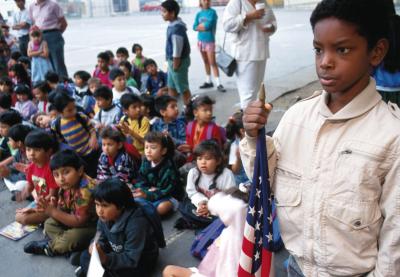The problem of the 21st century will be the problem of the color line. ... By any standard of measurement or evaluation the problem has not been solved in the 20th century and thus becomes part of the legacy and burden of the next century.
—Historian John Hope Franklin, echoing the words of W.E.B. DuBois at a different century's turn
School desegregation, celebrated as a historic accomplishment, is being abandoned in practice as much of urban America turns back to segregated neighborhood schools. The abandonment is driven, in part, by Supreme Court decisions ending desegregation orders.
Some say that this demonstrates that desegregation failed and that we are worse off than before the famous court decision whose 50th anniversary we are celebrating.
Others assume — perhaps because of the little discussion of desegregation in educational policy debates — that we have done all that can be done.
Still, an overwhelming majority of Americans favor desegregated schools. Likewise, almost all parents want their children to be prepared to get along with children of all backgrounds in a society that is on pace to become half non-white within their lifetimes.
According to a recent Gallup Poll, increasing majorities of Americans believe that integration has improved the quality of education for both Blacks and Whites. This does not mean that most Americans do not also prefer neighborhood schools — they do — but it makes clear that most people would like integrated schools if they didn't have to do anything in order to get them.
The truth about the desegregation story is that we did accomplish a great deal — when we were serious about it.
When all branches of government worked together for a few years in the 1960s, the South went from almost total racial separation to become the region with the nation's most integrated schools. In fact, most parents whose children went to integrated schools and most students who now attend them see it as a very positive experience that tends to have lasting impacts on their lives.
But we, the people, haven't put any real effort into desegregation in several decades. Perhaps because we have failed to demand continued diligence in creating an integrated society, our executive and legislative leaders have forgotten the promise of Brown — while the courts have been moving backward.

Why should we care?
School desegregation originally began to ensure the constitutional rights for Black — and later Latino — students under the Fourteenth Amendment. Fifty years later, we have additional reasons to continue Brown's worthy pursuit.
First, racial segregation is strongly linked to segregation by class: Nearly 90% of intensely segregated schools for Blacks and Latinos are also schools in which at least half of the student body is economically disadvantaged.
These schools are traditionally associated with fewer resources, fewer advanced course offerings, more inexperienced teachers and lower average test scores. At the same time, despite the unequal resources that are traditionally associated with high poverty and minority schools, students in these schools are being subjected to increasingly rigorous testing that can have serious stakes attached for student promotion and graduation.
Second, decades of social science research has found that racially diverse classrooms improve student experiences: enhanced learning, higher academic achievement for minorities, higher educational and occupational aspirations, increased civic engagement, a greater desire to live, work, and go to school in multiracial settings, and positive, increased social interaction among members of different racial and ethnic backgrounds. Significantly, these benefits affect both white and minority students.
The power to change
Today our public schools are more segregated than they were in 1970, before the Supreme Court ordered busing and other measures to achieve desegregation.
Supreme Court decisions of the 1990s have made it easier for urban school districts to be released from decades-old desegregation plans.
In some areas, very high levels of integration remain. In others, particularly our large central city districts that educate one-quarter of black and Latino students, high levels of isolation by race and poverty exist. In many large suburban districts, rapid racial change and spreading segregation are occurring.
We have learned a great deal about how to design policies to encourage racial diversity, such as coordinating efforts to tackle residential and school desegregation.
As our country grows increasingly multiracial and this diversity expands into our suburban areas, we must think carefully about not replicating policies of resegregation that have produced the overwhelmingly minority and poor inner-city school systems.
The growth of the charter school movement, which neglected segregation issues and has unfortunately contributed to resegregation, especially for black students, is an example of how essential it is to incorporate equity provisions into any new education reform, particularly when residential segregation remains so high.
We must ensure that where desegregated schools exist, segregation within the school does not minimize interracial exposure. To that end, teachers must be trained in techniques to create positive environments that maximize the benefits of racial diversity. And students must rise up and help us cross our nation's long-standing racial and ethnic divide.
Finally, we — young and old, rich, poor and working class — all of us, across racial and ethnic lines, must remember the words of the Rev. Dr. Martin Luther King:
Desegregation simply removes... legal and social prohibitions. Integration is creative, and is therefore more profound and far-reaching. Integration is the positive acceptance of desegregation and the welcomed participation of Negroes into the total range of human activities.
His solution, as ours should be, is not to abandon desegregation, but to deepen it.
Segregation Today
Excerpted from A Multiracial Society with Segregated Schools: Are We Losing the Dream?, a 2003 report from social scientists at Harvard's Civil Rights Project that outlines the nature and scope of contemporary school segregation.
At the dawn of the 21st century, education for Blacks is more segregated than it was in 1968.
Black students are the most likely racial group to attend what researchers call "apartheid schools," — schools that are virtually all non-white and where poverty, limited resources, social strife and health problems abound. One-sixth of America's black students attend these schools.
Whites are the most segregated group in the nation's public schools. Only 14% of white students attend multiracial schools (where three or more racial groups are present).
Latino students are the most segregated minority group in U.S. schools. They are segregated by race and poverty; immigrant Latinos also are at risk of experiencing linguistic segregration.
Asian American students are the most integrated group in the nation's public schools. Three-fourths of Asian Americans attend multiracial schools.
Racial segregation in schools is strongly linked to segregation by class. Nearly 90% of intensely segregated, black and Latino schools are also schools where at least half of the student body is economically disadvantaged.
Residential segregation impacts schools. With the decrease in busing to achieve school integration and the overwhelming return to neighborhood schools, where we live matters.
Today's segregated schools are still unequal. Segregated schools have higher concentrations of poverty, much lower test scores, less experienced teachers and fewer advanced placement courses.
Students in integrated schools perform better on tests, possess elevated aspirations for educational and occupational attainment, and lead more integrated lives.
